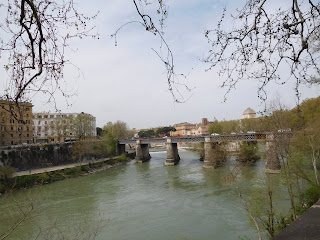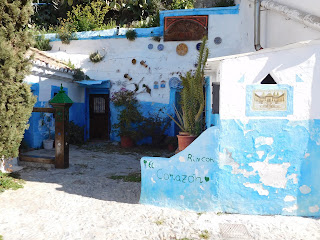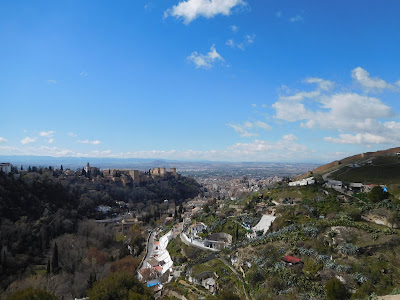[Note: now we are actually in feria]
¡Venga, vamos,
me parece que estamos en FERIA! Today is Easter Sunday and so the last day
of Semana Santa. Whereas in the United States Easter is the culmination of Lent
and a commercialized mess that involves Easter bunnies and chocolate eggs,
Easter Sunday is much more casual here in Sevilla. In fact, today feels more
like the official start to Feria than anything.
As you may know, or not because I haven’t blogged about it yet, I spent
the first part of my spring break in Paris [blog coming soon] and then returned
to Sevilla early Wednesday morning to see some of Semana Santa and to spend
Easter with my host family. Mejor dicho I came home early to run myself
ragged during the marathon of Semana Santa and to spend Easter getting pumped
for Feria and pretending to work on my various essays. Here’s an overview of my
first (but certainly not last) Semana Santa experience here in Sevilla!
First of all, what the heck is Semana Santa?
 Semana Santa is the week leading up to Easter. It traditionally
starts on Palm Sunday (Domingo de Ramos) but Sevilla decided it couldn’t
get enough so it now starts on the Friday before Palm Sunday with Viernes de
Dolores and Sábado de Pasion. Throughout the week different hermandades
salen con sus pasos por la ciudad. It’s hard to explain but basically the
different church organizations, think knights of Columbus but for all ages,
process around the city with these huge like-like sculptures/scenes of Jesus
and Mary. The sculptures are carried on gigantic wooden platforms decorated
with flowers and candles and are carried by dozens of men. They are accompanied
by members of the organization ranging from little babies to teenagers to
adults to senior citizens. These people are often dressed up as nazarenos (with the KKK style hood). The processions can last up to 14 hours and a supposed to be an act of penance. The hoods are worn so that the people walking can do their penance anonymously. People will often walk barefoot as well.. The hermandades
walk all through the city, each on its own route, but all of them do the Carrera
Official and process from La Campana to/through the Cathedral. It’s hard to explain but it’s one of the
most amazing things I have ever witnessed. It’s sad that nothing like this
would happen in the United States. I’m sure someone would be offended. The
thing is, while it’s religious it’s also hugely cultural. One of my professors
and Sevillan born and raised and very strongly agnostic and he thinks it’s the
most amazing display of culture he’s ever seen and his studies have literally
taken him all over the world. [Note: “pasos” are both the sculptures and
the procession as a whole]
Semana Santa is the week leading up to Easter. It traditionally
starts on Palm Sunday (Domingo de Ramos) but Sevilla decided it couldn’t
get enough so it now starts on the Friday before Palm Sunday with Viernes de
Dolores and Sábado de Pasion. Throughout the week different hermandades
salen con sus pasos por la ciudad. It’s hard to explain but basically the
different church organizations, think knights of Columbus but for all ages,
process around the city with these huge like-like sculptures/scenes of Jesus
and Mary. The sculptures are carried on gigantic wooden platforms decorated
with flowers and candles and are carried by dozens of men. They are accompanied
by members of the organization ranging from little babies to teenagers to
adults to senior citizens. These people are often dressed up as nazarenos (with the KKK style hood). The processions can last up to 14 hours and a supposed to be an act of penance. The hoods are worn so that the people walking can do their penance anonymously. People will often walk barefoot as well.. The hermandades
walk all through the city, each on its own route, but all of them do the Carrera
Official and process from La Campana to/through the Cathedral. It’s hard to explain but it’s one of the
most amazing things I have ever witnessed. It’s sad that nothing like this
would happen in the United States. I’m sure someone would be offended. The
thing is, while it’s religious it’s also hugely cultural. One of my professors
and Sevillan born and raised and very strongly agnostic and he thinks it’s the
most amazing display of culture he’s ever seen and his studies have literally
taken him all over the world. [Note: “pasos” are both the sculptures and
the procession as a whole]
Semana Santa is a holiday in all of Spain but each
area of the county celebrates it differently. Even here in Andalucia there are
no two cities that celebrate it the same. From what I here it’s much more joyous
in the south and more somber up north. I also hear that Sevilla is a truly one
of a kind celebration.
So what did my Semana Santa look like?
Wednesday (Miercoles Santo): I got back from Paris pretty early on
Wednesday morning. I didn’t sleep much the night before so I went to bed as
soon as I got home and slept until lunch. My host sister was the only one home
during lunch so while she ate she described Semana Santa a bit to me and told
me about how it had rained earlier in the week so some of the pasos (the
sculpture/platforms) didn’t get to do their route. I had to tutor at five and I
left a bit early to walk through the center of the city to see what was going
on. It was crazy. I saw a little bit of one paso and then got yelled at
because I was apparently in a ticketed area and I obviously didn’t have a
ticket. After tutoring my favorite nine year old, I saw the paso of El
Baratillo before stumbling upon a cute vegetarian/vegan bakery where I
obviously had to get a snack. Then I went to a plaza behind the cathedral and
saw San Bernardo. It was pretty impresionante to see their Christ
sculpture, a crucifixion with red velvet detailing and purple flowers, in a
plaza between the cathedral, the Archive de Indias and the Alcázar. I felt like
I was transported to another century. Minus all of the smart phones being used
to take pictures. I called it a night pretty early and was home by dinner time
(read: 10pm).
 |
| Las Cigarreros |
Thursday (Jueves Santo): I knew that Thursday was going to be a
long day because it was La Madrugá, the early morning hours of Friday
where some of the biggest and oldest processions take place. I of course was an
idiot and didn’t take the day to rest so I was even more tired when nighttime
rolled around. My adventure started after lunch when I went to go see Las
Cigarreros, the only paso in Los Remedios which is my
neighborhood. I got there pretty early so I was in the first row. I got to take
a ton of cool pictures and see what happens close up. Some of the things, like
the little kids asking the nazerenos (the people with the KKK style
hoods) for candy as they walk by, you can’t see if you’re further back. I stood
next to an older woman and we talked a bit. The funniest thing was when two
women walked by smoking she turned to me and said, “Jeez, these days women
smoke more than the men…”
I had the perfect view of the paso as it came
around the corner onto calle Asuncion. The Christ always comes first and
this particular one, which has Roman soldiers on it as well, was just amazing
to see coming around the corner with the booming music of the band and the incense
smoke everywhere. The Virgen is a whole different story. After the Christ you
have to wait a bit to see her but when she’s getting close you can feel the
excitement growing. “Is she coming?” “Mama when is the Virgen coming?” “How
much longer?” When she came around the corner, hundreds of rose petals were
thrown off the balconies. Amazing. Beautiful. Wonderful. Perfect. As she went
by, a woman next me who was holding her grandson started crying because he
shouted “there’s Maria!” I looked around and she was certainly not the only one.
After that paso ended I spent the rest of the
afternoon planning out my route for La Madrugá. Once I found all of the
churches and streets that I was planning on going to I went to the grocery
store to stock up on candy to keep me awake. Since the streets are usually
packed it’s normal to go to the churches in the afternoon to see the pasos
up close. I went to Esperanza de Triana on calle Pureza and it
was literally INSANE. The street was packed 10 hours ahead of time. Trianeros,
that is people who live in Triana, are very proud of being from Triana, it used
to be a separate city. Everything is a big party in Triana!
 |
| Christ of the 3 falls- not my picture |
Early Early Friday morning (La Madrugá): I went back home to bundle up for the 45
degree weather and then went out to get Italian food with Caroline. After we
ate I set out to Plaza de San Lorenzo to wait for the salida
(leaving) of Gran Poder. I waited for two and a half hours, which was
rough but it was worth it. The time was also broken up by a parade of Roman Soldiers
who marched throughout the city entering in each of the churches before the pasos
leave. I loved this, it made me feel like I was actually watching Holy
Thursday/Good Friday happen 2,000 years ago. This is specific to La Madrugá.
Unlike some of the others Gran Poder left in silence and then when the
Christ appeared there was singing. After that, I headed to Puente de Triana
(a bridge) to see Esperanza de Triana. My host dad and one of my host
sisters walk in it; my host dad is one of the people who carry the Virgen. Esperanza
is long. Very long. Like two hours long. I will say, the Christ (Cristo
de las tres caídas/of the three falls) is 100% my favorite, especially with
the music and the Virgin is beautiful as well. I can’t explain how beautiful it
was when she passed right in front of me. After Esperanza I was getting
very tired, it was about 4:30am at this point. It’s hard when you don’t have
anyone to talk to and keep you motivated. I was jealous of all of the families
and friends that make a day out of each paso, setting up chairs early
and bringing picnics, enjoying each other as much as the main event.
 |
| El Silencio-Not my Picture |
The last paso
I saw was el Silencio which is the oldest hermandad in
Sevilla (from the 1300s). I watched them re-enter the church at the end of
their route. It was cool because it was also in silence. The paso of the
Virgen was decorated entirely in azahar, the flowers from the orange trees. I
had plans to go see La Macarena but the streets were all blocked and I
was very tired, it was about 6am at this point. Looking back, I’m sad I didn’t
see it but I don’t think I would have made the walk back home. I went back to Puente
de Triana and got churros and chocolate from the churros stand and sat
myself down for the first time in almost 8 hours. I enjoyed my greasy,
delicious churros with my favorite view of the city-looking over the river
toward Triana. Even though I was exhausted and a bit grumpy, everything was
perfect. I normally feel out of place when I’m surrounded by a bunch of Spanish
people but at that moment I didn’t really care. After that feeling passed over,
I speed-walked home, showered, and was in bed by 8am. My alarm went off for
getting up to tutor at 11am and I promptly sent the family a message saying
that I had gotten back late/early and asked if I could come after lunch
instead. Since the little girl’s dad is one of the guys who carry the Christ in
Gran Poder, they understood.
 |
| My favorite view, at sunrise |
Friday (Viernes Santo): I slept until lunch and then went to tutor
at five. At lunch my host sister was telling me about what it’s like to walk in
the procession and how she has done it since she was 12. The hemandades
seem very cool to me. I think I would want to be in one if I lived here. It’s
another thing that I love about the culture and wish I was a part of. She also
was telling me that she saw her dad at one point and called out “Alfonso
Alfonso!” but he didn’t reply. He said that he heard her but assumed someone
was calling a different Alfonso because “there are a million Alfonsos”. She said
that all of the pasos stop at this one chapel for a mini-breakfast and
when she was eating she could see both the Christ and the Virgen (which is
usually impossible) and that it was so impresionante she cried. If you
couldn’t tell, Semana Santa is very emotional for the Sevillanos. On the way
home from tutoring I watched two more pasos on el puente (bridge).
They were much shorter than Esperanza!
Saturday (Sábado Santo): I went out to dinner in Santa Cruz (the
Old Jewish Quarter) with Caroline and her aunt who was visiting. She was really
interesting and I loved hearing about their trip but I was super surprised to
hear such a thick southern accent after having been in Spain for such a long time!
I forgot what they sound like! Afterward I went to the chapel at the University
for an Easter Vigil mass. It was long but beautiful. There was also a baptism
and I thought the priest’s words about the new member (a younger boy) were
beautiful, about how all of the saints now had a new son/brother and how he had
this whole new family. I loved it. Equally powerful was when we sang “Ave Maria”
at the end and the Virgen was still on her paso with all the flowers and
candles inside the chapel. After mass there was a social in the university with
hot chocolate and lots of traditional sweets. I met a group of girls from the
US so I talked to them, ate a bit, and then headed home.
Easter (La Pascua): Sunday morning I got up and went to my usual spot, Café
de Indias, to work on my various papers before heading over to Plaza de España
for a sevillanas class. Like usual I had a blast and I met a girl who is
here teaching with the government program that I was thinking about for next
year. She says she loves it and she’s coming back next year as well. The
program seems really cool, except that you can’t chose exactly where you want
to be placed. After the class we went to go have a drink and talk about being
American in Sevilla. I went home for lunch. Since it was a holiday we had a
lunch de fiesta, meaning lots of food and wine. Just like with
Christmas, I have realized that the only thing you really need to do for a
holiday is have good food and good conversation. That’s it. Later, I went to
the park to sit in the sun for a bit and then walked around the fairgrounds.
 |
| Puerta de Feria! |
That was that for my Semana Santa. Some people don’t like it but I
thought it was absolutely amazing. The culture is amazing and I’m always sad
that we don’t have anything close to similar in the United States. The aspect
of community/family was beautiful to watch but made me sad that I did most of
it alone. Most of the other study abroaders were traveling and my Spanish
friends had all gone back to their respective towns. I had an interesting
conversation with the girl I met in my sevillanas class about how hard
it was to make Spanish friends from Sevilla. Even though it’s a city, people born
here tend to stay here and so the friends that they have are friends that they’ve
had since they were two. Obviously this isn’t true in every case but it’s true
in every case I have seen. I understand- if you aren’t looking for friends you
aren’t going to look for friends, especially with people who aren’t here permanently.
This is why I’ve had so much more success with Erasmus students (European students
studying abroad) and people from other parts of Spain.


















